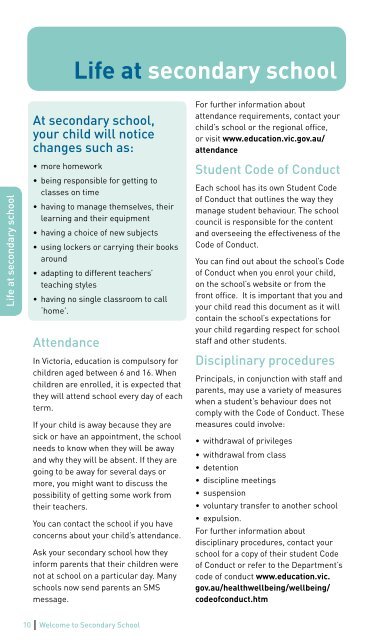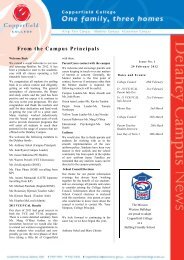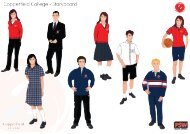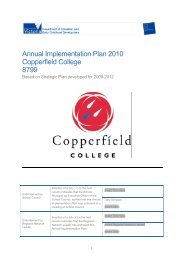Welcome to Secondary School PDF - Copperfield College
Welcome to Secondary School PDF - Copperfield College
Welcome to Secondary School PDF - Copperfield College
You also want an ePaper? Increase the reach of your titles
YUMPU automatically turns print PDFs into web optimized ePapers that Google loves.
Life at secondary school<br />
Life at secondary school<br />
At secondary school,<br />
your child will notice<br />
changes such as:<br />
• more homework<br />
• being responsible for getting <strong>to</strong><br />
classes on time<br />
• having <strong>to</strong> manage themselves, their<br />
learning and their equipment<br />
• having a choice of new subjects<br />
• using lockers or carrying their books<br />
around<br />
• adapting <strong>to</strong> different teachers’<br />
teaching styles<br />
• having no single classroom <strong>to</strong> call<br />
‘home’.<br />
Attendance<br />
In Vic<strong>to</strong>ria, education is compulsory for<br />
children aged between 6 and 16. When<br />
children are enrolled, it is expected that<br />
they will attend school every day of each<br />
term.<br />
If your child is away because they are<br />
sick or have an appointment, the school<br />
needs <strong>to</strong> know when they will be away<br />
and why they will be absent. If they are<br />
going <strong>to</strong> be away for several days or<br />
more, you might want <strong>to</strong> discuss the<br />
possibility of getting some work from<br />
their teachers.<br />
You can contact the school if you have<br />
concerns about your child’s attendance.<br />
Ask your secondary school how they<br />
inform parents that their children were<br />
not at school on a particular day. Many<br />
schools now send parents an SMS<br />
message.<br />
For further information about<br />
attendance requirements, contact your<br />
child’s school or the regional office,<br />
or visit www.education.vic.gov.au/<br />
attendance<br />
Student Code of Conduct<br />
Each school has its own Student Code<br />
of Conduct that outlines the way they<br />
manage student behaviour. The school<br />
council is responsible for the content<br />
and overseeing the effectiveness of the<br />
Code of Conduct.<br />
You can find out about the school’s Code<br />
of Conduct when you enrol your child,<br />
on the school’s website or from the<br />
front office. It is important that you and<br />
your child read this document as it will<br />
contain the school’s expectations for<br />
your child regarding respect for school<br />
staff and other students.<br />
Disciplinary procedures<br />
Principals, in conjunction with staff and<br />
parents, may use a variety of measures<br />
when a student’s behaviour does not<br />
comply with the Code of Conduct. These<br />
measures could involve:<br />
• withdrawal of privileges<br />
• withdrawal from class<br />
• detention<br />
• discipline meetings<br />
• suspension<br />
• voluntary transfer <strong>to</strong> another school<br />
• expulsion.<br />
For further information about<br />
disciplinary procedures, contact your<br />
school for a copy of their student Code<br />
of Conduct or refer <strong>to</strong> the Department’s<br />
code of conduct www.education.vic.<br />
gov.au/healthwellbeing/wellbeing/<br />
codeofconduct.htm<br />
10 <strong>Welcome</strong> <strong>to</strong> <strong>Secondary</strong> <strong>School</strong>



![Download file [510kb] - Copperfield College](https://img.yumpu.com/51107803/1/184x260/download-file-510kb-copperfield-college.jpg?quality=85)


![Download file [779kb] - Copperfield College](https://img.yumpu.com/42911062/1/184x260/download-file-779kb-copperfield-college.jpg?quality=85)
![Download file [2mb] - Copperfield College](https://img.yumpu.com/41859432/1/184x260/download-file-2mb-copperfield-college.jpg?quality=85)
![Download file [4mb] - Copperfield College](https://img.yumpu.com/41615904/1/184x260/download-file-4mb-copperfield-college.jpg?quality=85)
![Download file [6mb] - Copperfield College](https://img.yumpu.com/36534567/1/184x260/download-file-6mb-copperfield-college.jpg?quality=85)
![Download file [1mb] - Copperfield College](https://img.yumpu.com/35205064/1/184x260/download-file-1mb-copperfield-college.jpg?quality=85)
![Download file [1mb] - Copperfield College](https://img.yumpu.com/33612048/1/184x260/download-file-1mb-copperfield-college.jpg?quality=85)

![Download file [329kb] - Copperfield College](https://img.yumpu.com/24266313/1/184x260/download-file-329kb-copperfield-college.jpg?quality=85)
![Download file [3mb] - Copperfield College](https://img.yumpu.com/24168443/1/184x260/download-file-3mb-copperfield-college.jpg?quality=85)
![Download file [2mb] - Copperfield College](https://img.yumpu.com/23294183/1/184x260/download-file-2mb-copperfield-college.jpg?quality=85)
![Download file [3mb] - Copperfield College](https://img.yumpu.com/23045840/1/184x260/download-file-3mb-copperfield-college.jpg?quality=85)